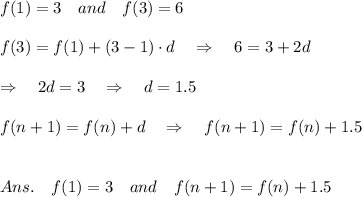
Mathematics, 25.08.2019 17:10, Tuxkie
Three terms of an arithmetic sequence are shown. f(1)=3, f(3)=6, f(7)=12 what recursive formula could define the sequence ? a. f(n+1)=2f(n) b. f(n+1)=f(n)+3 c. f(n+1)=f(n)+1.5 d. f(n+1)=0.5f(n)

Answers: 1
Other questions on the subject: Mathematics


Mathematics, 21.06.2019 21:50, amakayla57
What is the next step in the given proof? choose the most logical approach. a. statement: m 1 + m 2 + 2(m 3) = 180° reason: angle addition b. statement: m 1 + m 3 = m 2 + m 3 reason: transitive property of equality c. statement: m 1 = m 2 reason: subtraction property of equality d. statement: m 1 + m 2 = m 2 + m 3 reason: substitution property of equality e. statement: 2(m 1) = m 2 + m 3 reason: substitution property of equality
Answers: 3

Mathematics, 21.06.2019 22:10, markayla101326
In which direction does the left side of the graph of this function point? f(x) = 3x3 - x2 + 4x - 2
Answers: 2
Do you know the correct answer?
Three terms of an arithmetic sequence are shown. f(1)=3, f(3)=6, f(7)=12 what recursive formula coul...
Questions in other subjects:

Mathematics, 15.03.2022 03:40


Mathematics, 15.03.2022 03:40

Mathematics, 15.03.2022 03:40



Health, 15.03.2022 03:40

English, 15.03.2022 03:40


Mathematics, 15.03.2022 03:40


![an\ arithmetic\ sequence:\\\\ d\ \ \rightarrow\ \ the\ difference\\\\f(n)=f(1)+(n-1)\cdot d\\\\f(n+1)=f(1)+n\cdot d\\\\f(n+1)-f(n)=f(1)+n\cdot d-[f(1)+n\cdot d- d]=\\\\=f(1)+nd-f(1) -nd+d=d\\\\\Rightarrow\ \ \ f(n+1)=f(n)+d](/tpl/images/0196/9522/4ffae.png)





